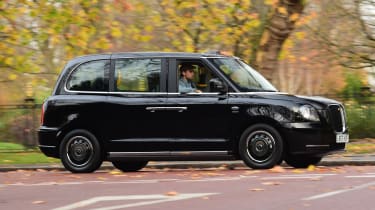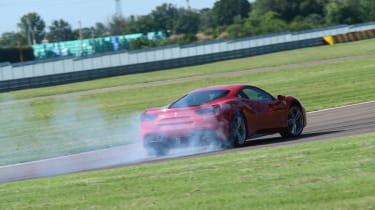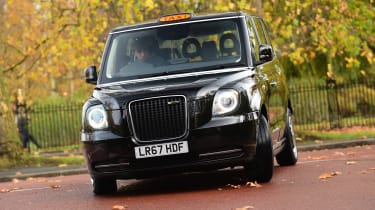New London Taxi LEVC TX review
The new LEVC TX will soon be commonplace on the streets of London, but is the new taxi up to the job? We find out...
If you’re fed up with riding around in a taxi that seems from a different era, then the new TX will really delight. It’s smooth, quiet and comfortable and has many modern touches commuters need. But if you’re a cabbie the transformation from old TX4 to new TX is unbelievable. It drives much like a modern hybrid SUV and won’t make cabbies feel like second-class drivers anymore.
Considering its importance to the fabric of London life, it’s remarkable there have only ever been a handful of taxi models built solely for the Capital. Unlike the other cars Auto Express reviews, there are not brand new taxis every year – rather there are landmark taxis over the last 70 years that have trudged on, lightly updated, and ferried the millions, if not billions, of people around London.
The story can be loosely boiled down two three models – the Austin FX3 of 1949, followed by the 1958 FX4 (which became the Fairway in 1989) and the TX1 launched in 1997. This new TX, though, is easily the biggest step-change.
It still holds onto a number of features from its predecessors, however. Like the FXs and TXs, the new one is totally bespoke for London – it’s not a Mercedes Vito that’s been adapted for life on the Big Smoke’s streets, for example – and there’s a nod to the ‘bowler hat’ design and suicide doors. The other similarities are legal – it has to have wheelchair access and it must have a turning circle of 25 feet (that’s the width of the turning circle outside the Savoy hotel). But from here on it’s totally different.
The name is a clue to how different it is. The ‘traditional’ London taxi builder has been known as Carbodies, London Taxis International and the London Taxi Company over the years. But now, owned by the Chinese powerhouse Geeley, the firm calls itself the London Electric Vehicle Company – or LEVC – and has a super smart new £325m factory in Coventry for the production of electric vehicles.
Used - available now

2023 MINI
Cooper Electric
22,248 milesAutomaticElectric
Cash £12,687
2021 Nissan
Leaf
17,471 milesAutomaticElectric
Cash £11,387
2022 Citroen
e-C4
27,861 milesAutomaticElectric
Cash £12,987
2020 Ford
Focus
17,904 milesManualPetrol1.0L
Cash £14,400The TX is the first new product to trundle down the new production line, but it’s not completely electric though. Under its stylish but retro body, there’s a 1.5-litre three-cylinder petrol engine from another Geeley brand – Volvo. At the back there’s an electric motor powering the rear wheels, but LEVC makes a big point of the TX not being a hybrid. To them, ‘hybrid’ means only one thing – the Toyota Prius – so refers to the TX as a range-extender like the BMW i3.
It drives much like your typical range extender, too. There’s around an 80-mile pure electric range so it means for the vast majority of a cabbie’s shift, they’ll be gliding around on electric power, with the engine kicking in occasionally to extend the range (this is when the TX is in ‘Smart’ mode; there are two other modes ‘Pure EV’ and ‘Save’ which stores the electricity). There’s none of the old TX4’s wailing diesel engine and black smoke pouring out the exhaust here.
The TX is as smooth and quiet as most EVs around town; the ride is good and TX is simple, easy and enjoyable to drive. The only really gripes being a bit of road noise, a regenerative brake pedal that is to modulate pressure with, and with that electric motor generating 255Nm of torque, the rear wheels have a tendency to spin up.
Up front and it’s like being in a large SUV. There’s a commanding driving position, the doors are thick and there’s good visibility. The SUV theme continues when you look at the controls as almost all the touch-points – the wheel, stalks, gearlever, start/stop switch and even the key – are pinched from the Volvo XC90. There’s even the Volvo’s nine-inch portrait touchscreen too. There’s a slightly different software theme but it works in the same way.
There’s a range of three trims; basic equipment includes the touchscreen, a panoramic roof, auto lights and wipers and rear parking sensors while our top spec cab throws in sat-nav and front parking sensors. Overall it couldn’t be more different to the cramped seating position and haphazard dashboard layout in the outgoing diesel-powered TX4 cab.
In the back and it’s similarly new world. There’s now space for six, there are conveniences like USB charging ports and a three-pin socket, and there’s even climate control and on-board wi-fi. But it’s the panoramic roof that’s the real boon – well it is in December, whether punters will enjoy it in mid-July is another thing.
On our test drive we were stopped by a dozen cabbies all wanting to know more about the TX. It’s new look and electric driving range excited all those who stopped us, but there are concerns there aren’t enough rapid chargers in London to top up the TX’s batteries. And despite reasonable weekly payment plans, there’s no overlooking the TX’s asking price (it starts at £55,599) is strong. Despite this though, the TX is exactly the taxi London needs and wants.









